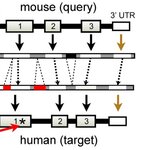Genetics & Molecular Biology

A study led by McGill University researchers has demonstrated that small differences between individuals at the DNA level can lead to dramatic differences in the way genes produce proteins. These, in turn, are responsible for the vast array of differences in physical characteristics between individuals.
The study was originally initiated by Dr. Tom Hudson, former director of the McGill University and Genome Quebec Innovation Centre, and drew upon the data collected by the vast HapMap (Haplotype Map) Project, a global comparative map of the human genome, which Hudson and his colleagues were…

Researchers from the Monell Chemical Senses Center have attempted to count the number of genes that contribute to obesity and body weight - and it isn't a pretty number.
The findings suggest that over 6,000 genes, almost 25 percent of the genome, could help determine an individual’s body weight.
“Reports describing the discovery of a new ‘obesity gene’ have become common in the scientific literature and also the popular press,” notes Monell behavioral geneticist Michael G. Tordoff, PhD, an author on the study. “Our results suggest that each newly discovered gene is just one of the many…

A recent issue of Genome Research contains a report of the cat genome sequence (Pontius et al. 2007), adding Felis catus to the rapidly growing collection of animal genome sequences. One of the reasons that the number of mammal sequences is increasing so quickly is that there have been reduced standards for sequence coverage.
To wit, the cat is one of 24 mammal species approved by NHGRI for "low redundancy" sequencing, meaning that the sequence will be covered only 2-fold (vs. up to 7x coverage in dog, chimp, human, mouse, and rat). Moreover, in this report, only 60% of the euchromatic DNA…

When we think of the genetic changes that had to take place during our evolutionary history, we typically think of changes that resulted in a gain of function, like genetic changes that resulted in a larger and more sophisticated brain, improved teeth for our changing prehistoric diet, better bone anatomy for bipedalism, better throat anatomy for speech, and so on.
In many cases however, we have lost genes in our evolutionary history, and some of those losses have been beneficial.
The most widely known example, found in every introductory biochemistry textbook, is the sickle-cell mutation…

Cells keep a close watch over the transcriptome – the totality of all parts of the genome that are expressed in any given cell at any given time. Researchers at the Salk Institute for Biological Studies and the University of Missouri-Kansas City teamed up to peel back another layer of transcriptional regulation and gain new insight into how genomes work.
Converting the “genetic blueprint” into molecular building blocks requires two basic processes: transcription, which copies the information from DNA into RNA transcripts and takes place in the cell’s nucleus, and translation, where the RNA…

Genome rearrangements, resulting in variations in the numbers of copies of genes, occur when the cellular process that copies DNA during cell division stalls and then switches to a different genetic “template,” said researchers at Baylor College of Medicine in Houston in a report that appears today in the journal Cell.
The new mechanism is called replication. “Fork Stalling and Template Switching,” said Dr. James R. Lupski, Cullen professor of molecular and human genetics and vice chair of the department at BCM. It not only represents a new way in which the genome generates DNA copy number…

According to the Centers for Disease Control and Prevention, close to one-third of the population in the United States is obese and another third is overweight.
Excessive weight gain is elicited by alterations in energy balance, the finely modulated equilibrium between caloric intake and expenditure. But what are the factors that determine how much food is consumed?
Part of the mystery is unfolding in the laboratory of Maribel Rios, PhD, at the Sackler School of Graduate Biomedical Sciences at Tufts University School of Medicine in Boston. Through their work, Rios and colleagues have…

Viticulture, the growing of grapes Vitis vinifera, chiefly to make wine, is an ancient form of agriculture, dating as far back as the Neolithic and Early Bronze Ages.
We have a detailed understanding of how nurture affects the qualities of a grape harvest leading to the concept of terroir (the range of local influences that carry over into a wine). The nature of the grapes themselves has been less well understood but the publication of a high quality draft genome sequence of a Pinot Noir grape by an Italian-based multinational consortium may change that.
The genome of the grape is spread…

When humans began to migrate out of Africa about 100,000 years ago, their skin color gradually changed to adapt to their new environments. And when the last Ice Age ended about 10,000 years ago, marine ancestors of ocean-dwelling stickleback fish experienced dramatic changes in skin coloring as they colonized newly formed lakes and streams.
New research shows that despite the vast evolutionary gulf between humans and the three-spined stickleback fish, the two species have adopted a common genetic strategy to acquire the skin pigmentation that would help each species thrive in their new…

Surrounding the small islands of genes within the human genome is a vast sea of non-coding DNA. While most of this DNA is junk, some of it is used to help genes turn on and off.
Hopkins researchers write in Genome Research that they have now found that regulatory DNA, which contributes to inherited diseases like Parkinson’s or mental disorders, may be more abundant than we realized.
By conducting an exhaustive analysis of the DNA sequence around a gene required for neuronal development, Andrew McCallion, Ph.D., an assistant professor in the McKusick-Nathans Institute of Genetic Medicine,…